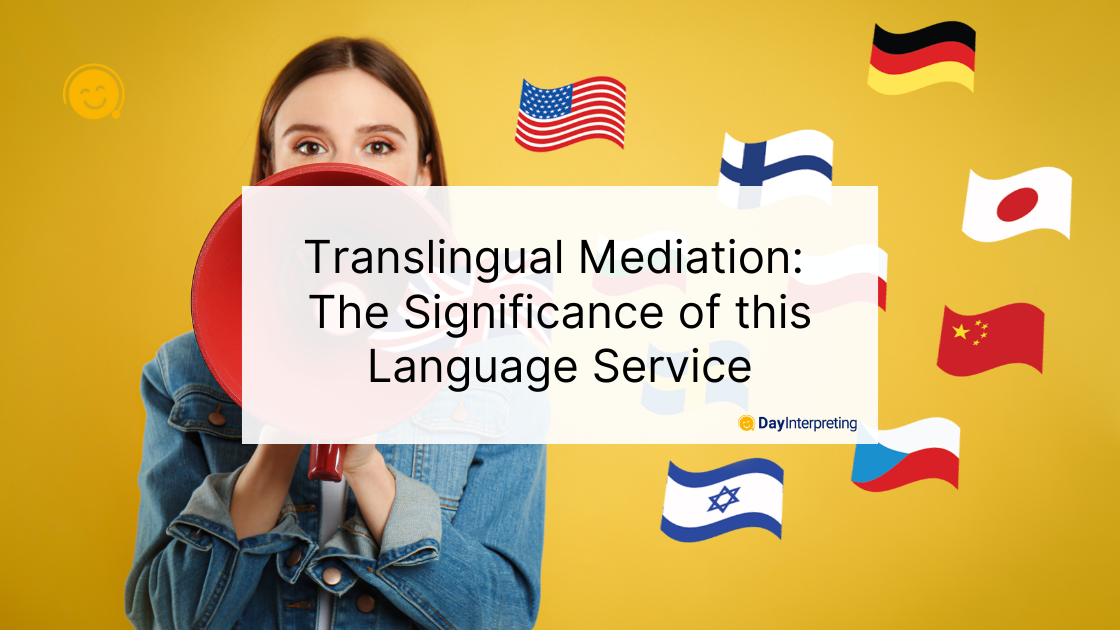Have you ever wondered what it’s like to be part of an immigrant family residing in a country where most family members do not speak their native language? That’s precisely why we are shedding light on translingual mediation today.
In today’s interconnected world, with travel and migration reaching unprecedented levels, such situations are far more prevalent than one might think. In the United States, approximately 14% of the population comprises immigrants born outside the country. Another statistic reveals that around 26% of the immigrant population in the US has children born within the United States.
You may be wondering why we are presenting you with these statistics; this is where the concept of translingual mediation comes into play. Many families rely on their children to act as translators and interpreters. In such instances, the children are engaged in translingual mediation.
In this article, we will delve into the essence of translingual mediation—what it entails, how it operates, and how it impacts the lives of children who find themselves in such circumstances.
What is Translingual Mediation?
Translingual mediation involves interpreting and translating for older family members who have limited understanding of the language spoken in the host country. The term “mediation” is employed because these children unintentionally assume the role of language interpreters and translators for their parents, especially in complex social and business situations.
Language Brokering: The Means to Cultural Bridge-Building
Translingual mediators play a crucial role as cultural bridge-builders within their families and communities. Their unique position allows them to foster understanding and facilitate communication between different cultures, making significant contributions to cultural exchange and integration.
Translingual mediators also act as cultural ambassadors, representing their family’s culture while interacting with individuals from the host culture. They serve as advocates, breaking down stereotypes and misconceptions, and promoting cross-cultural understanding. Their ability to bridge the cultural divide fosters empathy, respect, and appreciation for different traditions and perspectives.
In addition to their immediate family, translingual mediators have the potential to positively impact their wider community. Their role as cultural bridge-builders extends to schools, community organizations, and social settings. They can participate in multicultural events, share their experiences, and educate others about their cultural heritage. Through these interactions, they create inclusive environments that celebrate diversity and promote cultural integration.
The Emotional Impact of Linguistic and Cultural Translation When Children Act as Language Brokers
Translingual mediation places a significant emotional burden on children and youth who assume this role within their families. While they possess remarkable linguistic abilities, the weight of responsibility, pressure, and the constant juggling act between their own needs and the demands of translation and interpretation can take a toll on their emotional well-being.
One of the primary emotional challenges these young mediators face is their overwhelming sense of responsibility toward their family members. They may internalize the belief that it is their duty to bridge the language gap and ensure effective communication within the family. This responsibility can create feelings of stress as they constantly strive to convey messages accurately and interpret complex information.
The pressure to perform their role flawlessly can contribute to heightened anxiety. These children fear making translation or interpretation mistakes, worried that miscommunication might have significant consequences for their family. This constant pressure to meet high linguistic expectations can lead to self-doubt and anxiety about their abilities.
Balancing their needs and desires with the demands of translingual mediation presents an additional challenge. These young mediators may find themselves sacrificing personal time, social activities, or academic pursuits to fulfill their role as language intermediaries. This delicate balancing act can result in feelings of frustration, isolation, and a sense of missing out on typical childhood experiences.
Advantages and Disadvantages of Translingual Mediation
Translingual mediation arises when professional interpreters or translators are unavailable to assist. It is a situation where families in need prefer to rely on someone trustworthy to translate and interpret for them. With this in mind, translingual mediation has advantages and disadvantages, which we will explore below.
Advantages of Translingual Mediation
Children and youth have an exceptional ability to learn a new language and adapt to the culture of a new country. Here are a few advantages of translingual mediation:
- Development of bilingual and bicultural skills.
- Assisting the family in acclimatizing to their new environment and host country.
- Enhancement of communication skills and increased confidence.
- Development of confidentiality and discretion, valuable for future professional and sensitive situations.
- Improvement of interpersonal skills.
- Adaptability to different environments and functional operation in various settings.
- Pride in their abilities to help their family.
Disadvantages of Translingual Mediation
While there are considerable advantages to children engaging in translingual mediation, this role can also have disadvantages. Here are a few drawbacks associated with translingual mediation:
- Feelings of embarrassment when children misinterpret messages for their parents.
- Stress and anxiety in certain situations, fearing incorrect interpretation or translation.
- Exposure to language and information that may not be suitable for their age.
- Pressure on children to assist in decision-making at a young age.
The Role of Technology in Translingual Mediation
Technology, in the form of translation apps and online language resources, has become integral to translingual mediation, offering both support and complementarity to language service situations. While technology brings undeniable advantages, it is important to acknowledge its limitations in this context.
Translation apps and online language resources have revolutionized the way language mediation is approached. They provide quick and accessible language assistance, enabling instant translation and interpretation in various settings. These tools can be particularly helpful when immediate access to a professional interpreter or translator is not available. Translingual mediators can use these resources to clarify unfamiliar terms, verify meanings, or bridge language gaps during day-to-day conversations or casual interactions.
One of the significant advantages of technology is its convenience. With translation apps readily available on smartphones and online language resources accessible with just a few clicks, translingual mediators can rely on these tools for on-the-spot language support. They offer a level of efficiency and accessibility that traditional language resources may not always provide.
However, it is essential to recognize the limitations of technology in translingual mediation. While translation apps and online resources can provide quick translations, they may not always capture the nuances, cultural context, or idiomatic expressions accurately. Machine translation can sometimes lead to misunderstandings or misinterpretations, especially in complex or sensitive situations. The reliance on technology alone may overlook the human element necessary for effective communication, such as non-verbal cues, tone, and cultural subtleties.
Translingual mediators should approach technology as a tool that supports and complements their language skills, rather than solely relying on it. It is important to strike a balance between utilizing technology for immediate assistance and recognizing the value of human interpretation and cultural understanding in more complex or critical situations.
Wrapping Up
The term “translingual mediator” may not be commonly used, but the task of acting as one occurs on a daily basis. For many children and youths, it has become a part of their everyday lives and is considered a normal role.
Undoubtedly, the role of a translingual mediator is invaluable, particularly within newly arrived families who require assistance in navigating and accomplishing tasks in an unfamiliar language. However, it is important to note that translingual mediators, as children and youth, should not replace professional interpreters and translators. There are numerous situations where seeking professional help for conducting business or appointments is crucial. This is where Day Interpreting comes into play. Our team of professionals is available 24/7 to provide on-demand assistance with linguistic and cultural translation and interpretation.
By downloading our Day Interpreting app, you can access interpreters at the click of a button, ready to aid you in any situation. Give it a try today, and you’ll be glad you did.





0 Comments